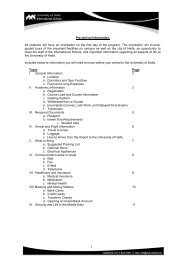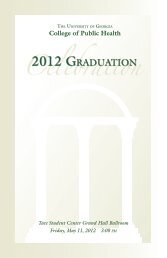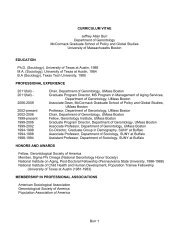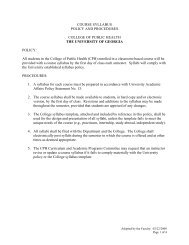MEASUREMENT MANUAL - College of Public Health - University of ...
MEASUREMENT MANUAL - College of Public Health - University of ...
MEASUREMENT MANUAL - College of Public Health - University of ...
Create successful ePaper yourself
Turn your PDF publications into a flip-book with our unique Google optimized e-Paper software.
1<br />
<strong>MEASUREMENT</strong> <strong>MANUAL</strong><br />
Aggression,<br />
Victimization, &<br />
Social Skills Scales<br />
Pamela Orpinas, PhD.<br />
The <strong>University</strong> <strong>of</strong> Georgia<br />
January 2009
Table <strong>of</strong> Contents<br />
Aggression Scale for Middle School Children....................................................2<br />
Items English Version.....................................................................................4<br />
Items Spanish Version....................................................................................5<br />
Victimization Scale for Middle School Children..................................................6<br />
Items English Version.....................................................................................8<br />
Items Spanish Version....................................................................................9<br />
Reduced Aggression and Victimization Scales................................................10<br />
Items.............................................................................................................12<br />
Positive Behavior Scales .................................................................................13<br />
Items.............................................................................................................14<br />
Parental Support for Fighting...........................................................................16<br />
Items English Version...................................................................................19<br />
Items Spanish Version..................................................................................20<br />
Suggested Citation:<br />
Orpinas, P. (2009). Measurement manual: Aggression, victimization, and social skills<br />
scales. Unpublished document, <strong>University</strong> <strong>of</strong> Georgia, Athens, USA. Available at:<br />
http://www.publichealth.uga.edu/hpb/research/hpb_youth_violence_orpinas.html<br />
Request for permission:<br />
Pamela Orpinas: porpinas@uga.edu<br />
January 2009 1
Aggression Scale for Middle School Children<br />
DESCRIPTION<br />
RESPONSE<br />
FORMAT<br />
INTENDED<br />
RESPONDENTS<br />
SCORING AND<br />
DIRECTION<br />
RELIABILITY<br />
MISSING<br />
VALUES<br />
The Aggression Scale for middle school children was designed to measure<br />
frequency <strong>of</strong> self-reported aggressive behaviors during the week prior to the<br />
survey. The scale was developed based on student and teacher input on<br />
most frequent children’s behavior. The scale is composed <strong>of</strong> 11 items.<br />
Because two <strong>of</strong> these items measure feelings <strong>of</strong> anger, some researchers<br />
have excluded them from the scale. However, in multiple studies, all 11 items<br />
have shown a high internal consistency.<br />
Orpinas and Frankowski (2001) described three studies on the psychometric<br />
properties <strong>of</strong> the scale. We have received hundreds <strong>of</strong> requests for the scale<br />
from multiple parts <strong>of</strong> the world, including Barbados, Canada, Chile, China,<br />
England, France, Germany, Ghana, India, Italy, Lithuania, Macedonia,<br />
Malaysia, Nigeria, Oman, Pakistan, Philippines, Slovakia, Saudi Arabia,<br />
South Africa, Spain, Sweden, and Turkey, as well as from almost all states in<br />
the United States. The scale was featured in the Clinician's Research Digest,<br />
a monthly publication <strong>of</strong> the American Psychological Association that<br />
summarizes the latest research for mental health practitioners. The scale<br />
was also described in CDC’s widely-utilized compendium <strong>of</strong> measures <strong>of</strong><br />
violence-related attitudes and behaviors (CDC, 1998, 2005;<br />
http://www.cdc.gov/ncipc/pub-res/measure.htm).<br />
0 = 0 times<br />
1 = 1 time<br />
2 = 2 times<br />
3 = 3 times<br />
4 = 4 times<br />
5 = 5 times<br />
6 = 6+ times<br />
The scale was developed for middle school students, grades 6-8. The<br />
authors have used it with upper elementary and high school students.<br />
The scores are additive, and the scale ranges from 0 to 66 points. High<br />
values indicate higher frequency <strong>of</strong> perpetrating aggressive behaviors.<br />
Based on data collected from two independent samples <strong>of</strong> young<br />
adolescents (n=253 and n=8,695; Orpinas & Frankowski, 2001), the internal<br />
consistency <strong>of</strong> the scores, as measured by Cronbach’s alpha, was .87 and<br />
.88, respectively. Internal consistency scores did not vary by gender or race.<br />
Scale scores were calculated if at least eight items were nonmissing.<br />
January 2009 2
NARRATIVE<br />
REFERENCE<br />
FOR THE SCALE<br />
OTHER<br />
REFERENCES<br />
The Aggression Scale measures self-reported aggressive behavior during<br />
the week prior to the survey. The Aggression Scale is composed <strong>of</strong> 11<br />
items, and responses can range from 0 times to 6 or more times per week.<br />
Responses are additive; thus, the scale can range between 0 and 66 points.<br />
Each point represents one aggressive behavior the student engaged in<br />
during the week prior to the survey. The scale includes behaviors such as<br />
teasing, pushing, name calling, hitting, encouraging students to fight, kicking,<br />
threatening to hurt or hit, and getting angry easily. The scores <strong>of</strong> the scale<br />
have shown high internal consistency in two separate studies (Cronbach’s<br />
alpha = .87 and .88) and good stability over time. More details about the<br />
construction <strong>of</strong> the aggression scale and its psychometric properties have<br />
been described elsewhere (Orpinas & Frankowski, 2001).<br />
Orpinas, P., & Frankowski, R. (2001). The aggression scale: A self-report<br />
measure <strong>of</strong> aggressive behavior for young adolescents. Journal <strong>of</strong> Early<br />
Adolescence, 21(1), 51-68.<br />
Dahlberg, L. L., Toal, S. B., Swahn, M., & Behrens, C. B. (2005). Measuring<br />
violence-related attitudes, behaviors, and influences among youths: A<br />
compendium <strong>of</strong> assessment tools. (2nd ed.) Atlanta, GA: Centers for<br />
Disease Control and Prevention, National Center for Injury Prevention and<br />
Control.<br />
COPYRIGHT The scale is free and available for schools and researchers to use upon<br />
request from the author.<br />
January 2009 3
Aggression Scale for Middle School Children<br />
Items English Version<br />
Think about what happened DURING THE LAST 7 DAYS, when you answer these questions.<br />
During the last 7 days:<br />
1. I teased students to make them<br />
angry.<br />
0<br />
times<br />
1<br />
time<br />
2<br />
times<br />
3<br />
times<br />
4<br />
times<br />
5<br />
times<br />
6 or<br />
more<br />
times<br />
0 1 2 3 4 5 6+<br />
2. I got angry very easily with someone. 0 1 2 3 4 5 6+<br />
3. I fought back when someone hit me<br />
first.<br />
4. I said things about other kids to make<br />
other students laugh.<br />
0 1 2 3 4 5 6+<br />
0 1 2 3 4 5 6+<br />
5. I encouraged other students to fight. 0 1 2 3 4 5 6+<br />
6. I pushed or shoved other students. 0 1 2 3 4 5 6+<br />
7. I was angry most <strong>of</strong> the day. 0 1 2 3 4 5 6+<br />
8. I got into a physical fight because I<br />
was angry.<br />
0 1 2 3 4 5 6+<br />
9. I slapped or kicked someone. 0 1 2 3 4 5 6+<br />
10. I called other students bad names. 0 1 2 3 4 5 6+<br />
11. I threatened to hurt or to hit someone. 0 1 2 3 4 5 6+<br />
January 2009 4
Escala de Agresión para Estudiantes<br />
Items Spanish Version<br />
Contesta las siguientes preguntas pensando en lo que realmente hiciste en los últimos 7<br />
días. Para cada pregunta, marca cuántas veces hiciste eso en los últimos 7 días.<br />
En los últimos 7 días... 0<br />
veces<br />
1. Yo hice bromas (molesté) a otros(as)<br />
estudiantes para que se enojaran.<br />
2. Yo me enojé fácilmente con otra<br />
persona.<br />
3. Yo respondí con golpes cuando<br />
alguien me golpeó primero.<br />
4. Yo dije cosas sobre otra persona para<br />
hacer reír a los(las) estudiantes.<br />
5. Yo alenté (estimulé, aconsejé) a<br />
otros(as) estudiantes a pelear.<br />
1<br />
vez<br />
2<br />
veces<br />
3<br />
veces<br />
4<br />
veces<br />
5<br />
veces<br />
6 veces<br />
o más<br />
0 1 2 3 4 5 6+<br />
0 1 2 3 4 5 6+<br />
0 1 2 3 4 5 6+<br />
0 1 2 3 4 5 6+<br />
0 1 2 3 4 5 6+<br />
6. Yo empujé a otros(as) estudiantes. 0 1 2 3 4 5 6+<br />
7. Yo estuve enojado(a) la mayor parte<br />
del día.<br />
8. Yo peleé a golpes (pelea a puños,<br />
tirar el pelo, morder) porque estaba<br />
enojado(a).<br />
9. Yo le di una b<strong>of</strong>etada (cachetada,<br />
palmada) o patada a alguien.<br />
10. Yo insulté a otros(as) estudiantes (les<br />
dije malas palabras).<br />
11. Yo amenacé a alguien con herirlo(a)<br />
o pegarle.<br />
January 2009 5<br />
0 1 2 3 4 5 6+<br />
0 1 2 3 4 5 6+<br />
0 1 2 3 4 5 6+<br />
0 1 2 3 4 5 6+<br />
0 1 2 3 4 5 6+
Victimization Scale for Middle School Children<br />
DESCRIPTION<br />
RESPONSE<br />
FORMAT<br />
INTENDED<br />
RESPONDENTS<br />
SCORING AND<br />
DIRECTION<br />
RELIABILITY<br />
MISSING<br />
VALUES<br />
The Victimization Scale for middle school children was designed to measure<br />
frequency <strong>of</strong> self-reported victimization during the week prior to the survey.<br />
The scale was developed based on the aggression scale for middle school<br />
students (Orpinas & Frankowski, 2001).<br />
The scale is also described in CDC’s widely-utilized compendium <strong>of</strong><br />
measures <strong>of</strong> violence-related attitudes and behaviors (CDC, 1998, 2005;<br />
http://www.cdc.gov/ncipc/pub-res/measure.htm).<br />
0 = 0 times<br />
1 = 1 time<br />
2 = 2 times<br />
3 = 3 times<br />
4 = 4 times<br />
5 = 5 times<br />
6 = 6+ times<br />
Middle school students, grades 6-8, and upper elementary students (grades<br />
3-5).<br />
The scores are additive, and the scale ranges from 0 to 60 points. High<br />
values indicate higher frequency <strong>of</strong> being the victim <strong>of</strong> aggressive acts.<br />
In a sample <strong>of</strong> 9115 middle school students from Texas, the internal<br />
consistency <strong>of</strong> the scores, as measured by Cronbach’s alpha, was .85 (Boys<br />
= .86; girls = .84). Pearson correlation between the Aggression Scale and<br />
the Victimization Scale was .50.<br />
Scale scores were only calculated if at least eight items were nonmissing.<br />
January 2009 6
NARRATIVE<br />
REFERENCES<br />
FOR THE SCALE<br />
The Victimization Scale measures the self-reported frequency <strong>of</strong> being the<br />
victim <strong>of</strong> aggressive acts during the week prior to the survey. It was<br />
developed based on the Aggression Scale (Orpinas & Frankowski, 2001).<br />
The Victimization Scale is composed <strong>of</strong> 10 items, and responses can range<br />
from 0 times to 6 or more times per week. Responses are additive; thus, the<br />
scale can range between 0 and 60 points. Each point represents one<br />
instance <strong>of</strong> victimization reported by the student during the previous seven<br />
days. The scale includes behaviors such as being teased, beat up, made<br />
fun <strong>of</strong>, encouraged to fight, called names, pushed, slapped, and threatened<br />
to be hurt or hit. The scores <strong>of</strong> the scale have shown high internal<br />
consistency (Cronbach’s alpha = .85) and a significant correlation (r = .50)<br />
with the Aggression Scale. The Victimization Scale has been used in prior<br />
research with middle school students (Kelder et al., 1996) and with<br />
elementary children (Orpinas, Horne, & Staniszewski, 2003).<br />
Dahlberg, L. L., Toal, S. B., Swahn, M., & Behrens, C. B. (2005). Measuring<br />
violence-related attitudes, behaviors, and influences among youths: A<br />
compendium <strong>of</strong> assessment tools. (2nd ed.) Atlanta, GA: Centers for<br />
Disease Control and Prevention, National Center for Injury Prevention and<br />
Control.<br />
Orpinas, P., & Frankowski, R. (2001). The aggression scale: A self-report<br />
measure <strong>of</strong> aggressive behavior for young adolescents. Journal <strong>of</strong> Early<br />
Adolescence, 21(1), 51-68.<br />
REFERENCES Kelder, S.H., Orpinas, P., McAlister, A., Frankowski, R., Parcel, G.S., &<br />
Friday, J. (1996). The Students for Peace Project: A comprehensive<br />
violence- prevention program for middle school students. American Journal<br />
<strong>of</strong> Preventive Medicine, 12(5), 22-30.<br />
Orpinas, P., Horne, A.M., Staniszewski, D. (2003). School Bullying:<br />
Changing the Problem by Changing the School. School Psychology Review,<br />
32(3), 431-444.<br />
Orpinas, P., Kelder, S., Frankowski, R., Murray, N., Zhang, Q., & McAlister,<br />
A. (2000). Outcome evaluation <strong>of</strong> a multi-component violence-prevention<br />
program for middle school students: The Students for Peace project. <strong>Health</strong><br />
Education Research, 15(1), 45-58.<br />
COPYRIGHT The scale is free and available for schools and researchers to use upon<br />
request from the author.<br />
January 2009 7
Victimization Scale for Middle School Children<br />
Items English Version<br />
Think about what happened DURING THE LAST 7 DAYS, when you answer these questions.<br />
During the last 7 days:<br />
1. A student teased me to make me<br />
angry.<br />
0<br />
times<br />
1<br />
time<br />
2<br />
times<br />
3<br />
times<br />
4<br />
times<br />
5<br />
times<br />
6 or<br />
more<br />
times<br />
0 1 2 3 4 5 6+<br />
2. A student beat me up. 0 1 2 3 4 5 6+<br />
3. A student said things about me to<br />
make other students laugh (made fun<br />
<strong>of</strong> me).<br />
4. Other students encouraged me to<br />
fight.<br />
0 1 2 3 4 5 6+<br />
0 1 2 3 4 5 6+<br />
5. A student pushed or shoved me. 0 1 2 3 4 5 6+<br />
6. A student asked me to fight. 0 1 2 3 4 5 6+<br />
7. A student slapped or kicked me. 0 1 2 3 4 5 6+<br />
8. A student called me (or my family)<br />
bad names.<br />
9. A student threatened to hurt or to hit<br />
me.<br />
0 1 2 3 4 5 6+<br />
0 1 2 3 4 5 6+<br />
10. A student tried to hurt my feelings. 0 1 2 3 4 5 6+<br />
January 2009 8
Escala de Victimización para Estudiantes<br />
Items Spanish Version<br />
Contesta las siguientes preguntas pensando en lo que realmente te pasó a ti en los últimos 7<br />
días. Para cada pregunta, marca cuántas veces otro estudiante te hizo algo en los últimos 7<br />
días.<br />
En los últimos 7 días... 0<br />
veces<br />
1. Un estudiante me hizo bromas (me<br />
molestó) para que yo me enojara.<br />
2. Un estudiante me dio una paliza<br />
(golpiza).<br />
3. Un estudiante dijo cosas sobre mí<br />
para hacer reír a otros estudiantes.<br />
4. Otros estudiantes me alentaron<br />
(estimularon, aconsejaron) a<br />
pelear.<br />
1<br />
vez<br />
2<br />
veces<br />
3<br />
veces<br />
4<br />
veces<br />
5<br />
veces<br />
6 veces<br />
o más<br />
0 1 2 3 4 5 6+<br />
0 1 2 3 4 5 6+<br />
0 1 2 3 4 5 6+<br />
0 1 2 3 4 5 6+<br />
5. Un estudiante me empujó. 0 1 2 3 4 5 6+<br />
6. Un estudiante me invitó a pelear. 0 1 2 3 4 5 6+<br />
7. Un estudiante me dio una b<strong>of</strong>etada<br />
(cachetada, palmada) o patada.<br />
8. Un estudiante me insultó a mí o a<br />
mi familia.<br />
9. Un estudiante me amenazó con<br />
herirme o golpearme<br />
10. Un estudiante trató de herir mis<br />
sentimientos.<br />
January 2009 9<br />
0 1 2 3 4 5 6+<br />
0 1 2 3 4 5 6+<br />
0 1 2 3 4 5 6+<br />
0 1 2 3 4 5 6+
Reduced Aggression and Victimization Scales<br />
DESCRIPTION<br />
RESPONSE<br />
FORMAT<br />
INTENDED<br />
RESPONDENTS<br />
SCORING AND<br />
DIRECTION<br />
RELIABILITY<br />
MISSING<br />
VALUES<br />
The Reduced Aggression and Victimization Scales (RAVS) were designed to<br />
measure the self-reported frequency <strong>of</strong> being victimized or being the<br />
perpetrator <strong>of</strong> aggressive behaviors during the week prior to the survey. The<br />
scales were developed by Pamela Orpinas as an elementary school version<br />
<strong>of</strong> the Aggression Scale (Orpinas & Frankowski, 2001). However, the scales<br />
have been used in middle schools. Each scale is composed <strong>of</strong> six items. The<br />
first four items <strong>of</strong> each scale measure overt aggression/victimization<br />
behaviors (teasing, name-calling, threats, and pushing or hitting). The last<br />
two items <strong>of</strong> each scale measure relational aggression/victimization.<br />
The scales were published by Orpinas & Horne (2006). The scale is also<br />
described in CDC’s widely-utilized compendium <strong>of</strong> measures <strong>of</strong> violencerelated<br />
attitudes and behaviors (CDC, 1998, 2005;<br />
http://www.cdc.gov/ncipc/pub-res/measure.htm).<br />
0 = 0 times<br />
1 = 1 time<br />
2 = 2 times<br />
3 = 3 times<br />
4 = 4 times<br />
5 = 5 times<br />
6 = 6+ times<br />
Upper elementary and middle school students.<br />
The scores are additive, and each scale ranges from 0 to 36 points. High<br />
values indicate higher frequency <strong>of</strong> aggression/victimization.<br />
In a study <strong>of</strong> fourth and fifth graders (n = 411), the internal consistency <strong>of</strong><br />
the scores, as measured by Cronbach’s alpha, was .86 (range by gender<br />
and race = .84 to .89) for aggression and .84 (range by gender and race =<br />
.80 to .87) for victimization (Orpinas & Horne, 2006). In a sample <strong>of</strong> middle<br />
school students (n = 903) the internal consistency <strong>of</strong> the scores was .89 (.89<br />
for boys, .86 for girls) for aggression and .87 (.88 for boys, .84 for girls) for<br />
victimization (Houston, 2007).<br />
Scale scores were calculated if at least five items were nonmissing in each<br />
scale.<br />
January 2009 10
NARRATIVE<br />
REFERENCE<br />
FOR THE SCALE<br />
The Reduced Aggression and Victimization Scales (RAVS) (Orpinas &<br />
Horne, 2006) measures the frequency <strong>of</strong> being victimized or <strong>of</strong> reporting<br />
aggressive behaviors during the previous week. The Reduced Aggression<br />
and Victimization Scales are composed <strong>of</strong> six items each, and responses<br />
can range from 0 times to 6 or more times per week. Scale scores are<br />
additive; thus, each scale can range from 0 to 36 points. Each point<br />
represents one instance <strong>of</strong> victimization or aggression reported by the<br />
student during the week prior to the survey. Each scale is composed <strong>of</strong> six<br />
items. Two <strong>of</strong> the items measure relational aggression/victimization and the<br />
other four measure overt behaviors (teasing, name-calling, threats, and<br />
pushing or hitting). In a sample <strong>of</strong> upper elementary students, the internal<br />
consistency <strong>of</strong> the scores measured by Cronbach’s alpha, was .86 for<br />
aggression and .84 for victimization. The Aggression and Victimization<br />
Scale-Short Version was adapted from the Aggression Scale (Orpinas &<br />
Frankwoski, 2001).<br />
Orpinas, P. & Horne, A. (2006). Creating a positive school climate and<br />
developing social competence. Washington, DC: American Psychological<br />
Association.<br />
REFERENCES Houston, K. P. (2007). Are there differences in bullies? An analysis <strong>of</strong><br />
bullying and social skills. Doctoral Dissertation, <strong>University</strong> <strong>of</strong> Georgia,<br />
Athens, GA.<br />
Orpinas, P., & Frankowski, R. (2001). The aggression scale: A self-report<br />
measure <strong>of</strong> aggressive behavior for young adolescents. Journal <strong>of</strong> Early<br />
Adolescence, 21(1), 51-68.<br />
COPYRIGHT The scale is free and available for schools and researchers to use upon<br />
request from the author.<br />
January 2009 11
Aggression & Victimization Scales-Short Version<br />
Items<br />
Think about what happened DURING THE LAST 7 DAYS, when you answer these<br />
questions about your CLASSROOM.<br />
During the last 7 DAYS:<br />
1. How many times did a kid from your<br />
classroom tease you?<br />
2. How many times did a kid from your<br />
classroom push, shove, or hit you?<br />
3. How many times did a kid from your<br />
classroom call you a bad name?<br />
4. How many times did kids from your<br />
classroom say that they were going to<br />
hit you?<br />
5. How many times did other kids in your<br />
classroom leave you out on purpose?<br />
6. How many times did a student in your<br />
classroom make up something about<br />
you to make other kids not like you<br />
anymore?<br />
7. How many times did you tease a kid<br />
from your classroom?<br />
8. How many times did you push, shove,<br />
or hit a kid from your classroom ?<br />
9. How many times did you call a kid<br />
from your classroom a bad name?<br />
10. How many times did you say that you<br />
would hit a kid in your classroom?<br />
11. How many times did you leave out<br />
another classmate on purpose?<br />
12. How many times did you make up<br />
something about other students in<br />
your classroom to make other kids not<br />
like them anymore.<br />
0<br />
times<br />
January 2009 12<br />
1<br />
time<br />
2<br />
times<br />
3<br />
times<br />
4<br />
times<br />
5<br />
times<br />
6 or<br />
more<br />
times<br />
0 1 2 3 4 5 6+<br />
0 1 2 3 4 5 6+<br />
0 1 2 3 4 5 6+<br />
0 1 2 3 4 5 6+<br />
0 1 2 3 4 5 6+<br />
0 1 2 3 4 5 6+<br />
0 1 2 3 4 5 6+<br />
0 1 2 3 4 5 6+<br />
0 1 2 3 4 5 6+<br />
0 1 2 3 4 5 6+<br />
0 1 2 3 4 5 6+<br />
0 1 2 3 4 5 6+
Positive Behavior Scales<br />
DESCRIPTION<br />
RESPONSE<br />
FORMAT<br />
INTENDED<br />
RESPONDENTS<br />
SCORING AND<br />
DIRECTION<br />
RELIABILITY<br />
MISSING<br />
VALUES<br />
NARRATIVE<br />
The Positive Behavior Scales was designed to measure the self-reported<br />
frequency <strong>of</strong> exerting or receiving positive behaviors during the 30 days prior<br />
to the survey. The scales were developed based on student and teacher<br />
input on most frequent positive children’s behavior in the classroom, as well<br />
as expected positive behaviors. Each scale is composed <strong>of</strong> 10 items. The<br />
time frame is the<br />
0 = Never<br />
1 = Once or twice<br />
2 = About once a week<br />
3 = Several times a week<br />
Upper elementary and middle school students, grades 3 to 8.<br />
High values indicate higher frequency <strong>of</strong> positive behaviors among students.<br />
In a sample <strong>of</strong> upper elementary students (n=206), the internal consistency<br />
<strong>of</strong> the scores, as measured by Cronbach’s alpha, was .90 (range by gender<br />
and race = .82 to .91) for being the recipient <strong>of</strong> positive behaviors and .91<br />
(range by gender and race = .89 to .92) for self-reported positive behaviors<br />
Scale scores can be calculated if at least eight items are nonmissing.<br />
The Positive Behavior Scales measure the frequency <strong>of</strong> exerting or receiving<br />
positive behaviors during the month prior to the survey. The Positive<br />
Behavior Scales are composed <strong>of</strong> two subscales: the first subscale assesses<br />
positive behaviors the student has experience from classmate, and the<br />
second subscale assesses positive behaviors the student has performed.<br />
Responses range from never to several times a week, in a 4-point scale.<br />
Item scores are added; thus, each scale ranges between 0 and 40 points.<br />
The scale includes behaviors such as complimenting, being polite, helping<br />
with something or <strong>of</strong>fering to help, sharing, and acting friendly.<br />
REFERENCES This measurement manual.<br />
January 2009 13
Positive Behavior Scales<br />
Items<br />
Think about what happened in your CLASSROOM during THE LAST 30 DAYS, when<br />
you answer these questions.<br />
In the past 30 DAYS, how many times, in<br />
your CLASSROOM:<br />
1. A kid said or did something nice to me.<br />
2. A kid said “thanks” or “you are welcome” to<br />
me.<br />
3. A kid helped me.<br />
4. A kid said or did something that made me<br />
feel good.<br />
5. A kid invited me to participate in a game,<br />
group conversation, or a class activity.<br />
6. A kid said a compliment (praise, kind word)<br />
to me.<br />
7. A kid <strong>of</strong>fered to help me.<br />
8. A kid shared something with me.<br />
9. A kid acted friendly with me.<br />
10. A kid showed interest in my ideas or<br />
activities.<br />
January 2009 14<br />
Never Once or<br />
twice<br />
About<br />
once a<br />
week<br />
Several<br />
times a<br />
week
In the past 30 DAYS, how many times did<br />
YOU:<br />
11. I said or did something nice to a kid from my<br />
classroom.<br />
12. I said “thanks” or “you are welcome” to a kid<br />
from my classroom.<br />
13. I helped a kid from my classroom.<br />
14. I said or did something that made a kid from<br />
my classroom feel good.<br />
15. I invited a kid from my classroom to<br />
participate in a game, group conversation,<br />
or a class activity.<br />
16. I said a compliment (praise, kind word) to a<br />
kid from my classroom.<br />
17. I <strong>of</strong>fered to help a kid from my classroom.<br />
18. I share something with a kid from my<br />
classroom.<br />
19. I acted friendly with a kid from my<br />
classroom.<br />
20. I showed interest in ideas or activities from<br />
a kid from my classroom.<br />
January 2009 15<br />
Never Once or<br />
twice<br />
About<br />
once a<br />
week<br />
Several<br />
times a<br />
week
Parental Support for Fighting<br />
DESCRIPTION<br />
RESPONSE<br />
FORMAT<br />
INTENDED<br />
RESPONDENTS<br />
SCORING AND<br />
DIRECTION<br />
The purpose <strong>of</strong> this 10-item measure is to evaluate the students’ perception<br />
<strong>of</strong> their parents’ support for aggressive and non-aggressive solutions as a<br />
means <strong>of</strong> solving conflicts. The questionnaire was first used as a single scale<br />
in the Students for Peace Project (Orpinas, Murray, & Kelder, 1999). Items<br />
were originally obtained from focus groups with middle schools students<br />
(Kelder et al., 1996; Orpinas et al., 2000). In other subsequent studies (e.g.,<br />
Miller-Johnson, Sullivan, Simon, & MVPP, 2004), two subscales were<br />
scored. One subscale consists <strong>of</strong> five items reflecting aggressive solutions to<br />
conflict, and the other subscale <strong>of</strong> the five items reflecting peaceful solutions.<br />
Students are asked to respond “yes” or “no” to each item based on what their<br />
parents tell them about fighting.<br />
0 = No<br />
1 = Yes<br />
Middle school students<br />
If scored as one scale: The total scale ranges between 0 and 10, and high<br />
score reflect more positive parental support for non-aggressive solutions. To<br />
compute the scale, items that support aggressive solutions are reverse<br />
coded (no = 1, yes = 0); then all items are added.<br />
If scored as two subscales, add or compute the mean <strong>of</strong> the following items:<br />
• Parental Support for Aggressive Solutions = items: 1, 2, 3, 5, 9<br />
• Parental Support for Non-aggressive Solutions = items: 4, 6, 7, 8, 10<br />
If added, each scale will range between 0 and 5; if the mean is computed,<br />
each scale will range between 0 and 1. In both cases, high scores indicate a<br />
stronger perception <strong>of</strong> parental support for aggressive solutions or nonaggressive<br />
solutions, respectively.<br />
January 2009 16
SCALE<br />
DEVELOPMENT<br />
RELIABILITY<br />
NARRATIVE<br />
The MVPP study (Miller-Johnson, Sullivan, Simon, & MVPP, 2004)<br />
conducted a set <strong>of</strong> confirmatory factor analyses (CFA) to compare a onefactor<br />
model with a two-factor model. The reasoning behind this comparison<br />
was that aggressive and non-aggressive solutions to conflict might represent<br />
two distinct constructs (two-factor model) instead <strong>of</strong> being opposite ends <strong>of</strong> a<br />
unitary construct (one-factor model). The models were compared using tauequivalent<br />
models, where all items loadings are constrained to 1. The table<br />
below summarizes fit indices. These analyses suggest that the two-factor<br />
model provided a better fit for the data. In the MVPP study, the two<br />
subscales had a moderate, negative correlation <strong>of</strong> -.45.<br />
Model Chisquare<br />
1. One factor with all<br />
10 items<br />
2. Two correlated<br />
factors (Support<br />
Fighting and Support<br />
Peaceful Solutions)<br />
df Chi-square<br />
change<br />
(with df<br />
change)<br />
RMSE<br />
A<br />
CF<br />
I<br />
2540.01 44 0.16 .88<br />
1291.73 42 1248.28(2) 0.11 .94<br />
The internal consistency <strong>of</strong> the total scale’s scores (Cronbach's Alpha) was<br />
.81 (Orpinas, Murray, & Kelder, 1999).<br />
In the MVPP study, the internal consistency <strong>of</strong> the scores <strong>of</strong> each subscale,<br />
as measured by Cronbach’s alpha, was :<br />
• Aggressive Solutions Scale = .62<br />
• Non-aggressive Solutions Scale = .66<br />
Parental Support for Fighting was designed to measure students' perception<br />
<strong>of</strong> their parents’ support for aggressive and non-aggressive solutions to<br />
conflict. The 10-item measure was developed for the Students for Peace<br />
Project (Orpinas, Murray, & Kelder, 1999) as one scale, and later used for<br />
the MVPP project (Miller-Johnson, Sullivan, Simon, & MVPP, 2004) as two<br />
subscales with five items each: Parental Support for Aggressive Solutions<br />
and Parental Support for Non-aggressive Solutions to conflict. At the<br />
beginning <strong>of</strong> the questionnaire students were asked, “Does your parent tell<br />
you these things about fighting?” Items are listed as declarative statements,<br />
and students respond yes or no to each item. An example <strong>of</strong> a peaceful<br />
solution item is, "If someone calls you names, ignore them." An aggressive<br />
solution item is, "If someone hits you, hit them back." Scores are based on<br />
the mean item response.<br />
January 2009 17
REFERENCES<br />
CITED<br />
COPYRIGHT<br />
Kelder, S.H., Orpinas, P., McAlister, A., Frankowski, R., Parcel, G.S., &<br />
Friday, J. (1996). The Students for Peace Project: A comprehensive<br />
violence- prevention program for middle school students. American Journal<br />
<strong>of</strong> Preventive Medicine, 12(5), 22-30.<br />
Miller-Johnson, S., Sullivan, T. N., Simon, T. R., & Multisite Violence<br />
Prevention Project. (2004). Evaluating the impact <strong>of</strong> interventions in the<br />
Multisite Violence Prevention Study - Samples, procedures, and measures.<br />
American Journal <strong>of</strong> Preventive Medicine, 26, 48-61.<br />
Orpinas, P., Kelder, S., Frankowski, R., Murray, N., Zhang, Q., & McAlister,<br />
A. (2000). Outcome evaluation <strong>of</strong> a multi-component violence-prevention<br />
program for middle school students: The Students for Peace project. <strong>Health</strong><br />
Education Research, 15(1), 45-58.<br />
Orpinas, P., Murray, N., & Kelder, S. (1999). Parental influences on<br />
students' aggressive behavior and weapon-carrying. <strong>Health</strong> Education and<br />
Behavior, 26(6), 774-787.<br />
The scale is free, and available for public use. Recommended citation:<br />
Orpinas, P., Murray, N., & Kelder, S. (1999). Parental influences on<br />
students' aggressive behavior and weapon-carrying. <strong>Health</strong> Education and<br />
Behavior, 26(6), 774-787.<br />
January 2009 18
Parental Support for Fighting Scale<br />
Items English Version<br />
Does your parent tell you these things about fighting?<br />
YES NO<br />
1. If someone hits you, hit them back. Y N<br />
2. If someone calls you names, hit them. Y N<br />
3. If someone calls you names, call them names<br />
back.<br />
Y N<br />
4. If someone calls you names, ignore them. Y N<br />
5. If someone asks you to fight, hit them first. Y N<br />
6. If someone asks you to fight, you should try to talk<br />
your way out <strong>of</strong> a fight.<br />
7. You should think the problem through, calm<br />
yourself, and then talk the problem out with your<br />
friend.<br />
8. If another student asks you to fight, you should tell<br />
a teacher or someone older.<br />
9. If you can't solve the problem by talking, it is best<br />
to solve it through fighting.<br />
10. No matter what, fighting is not good; there are<br />
other ways to solve problems.<br />
January 2009 19<br />
Y N<br />
Y N<br />
Y N<br />
Y N<br />
Y N
Apoyo Parental para Peleas<br />
Items Spanish Version<br />
¿Qué te dicen tus padres o guardianes sobre pelear?<br />
January 2009 20<br />
YES NO<br />
1. Si alguien te pega, pégale de vuelta. Y N<br />
2. Si alguien te insulta, pégale de vuelta. Y N<br />
3. Si alguien te insulta, insúltalo de vuelta. Y N<br />
4. Si alguien te insulta, ignóralo. Y N<br />
5. Si alguien te pide pelea, pégale primero. Y N<br />
6. Si alguien te pide pelea, trata de conversar para<br />
no pelear.<br />
7. Tú debes pensar el problema, calmarte, y<br />
después conversar el problema con tu amigo.<br />
8. Si otro estudiante te pide pelea, tú debes decirle<br />
a la pr<strong>of</strong>esora o a alguien mayor.<br />
9. Si no puedes resolver el problema conversando,<br />
es mejor resolverlo peleando.<br />
10. No importa lo que pase, pelear no es bueno, hay<br />
otras formas de resolver los problemas.<br />
Y N<br />
Y N<br />
Y N<br />
Y N<br />
Y N
















